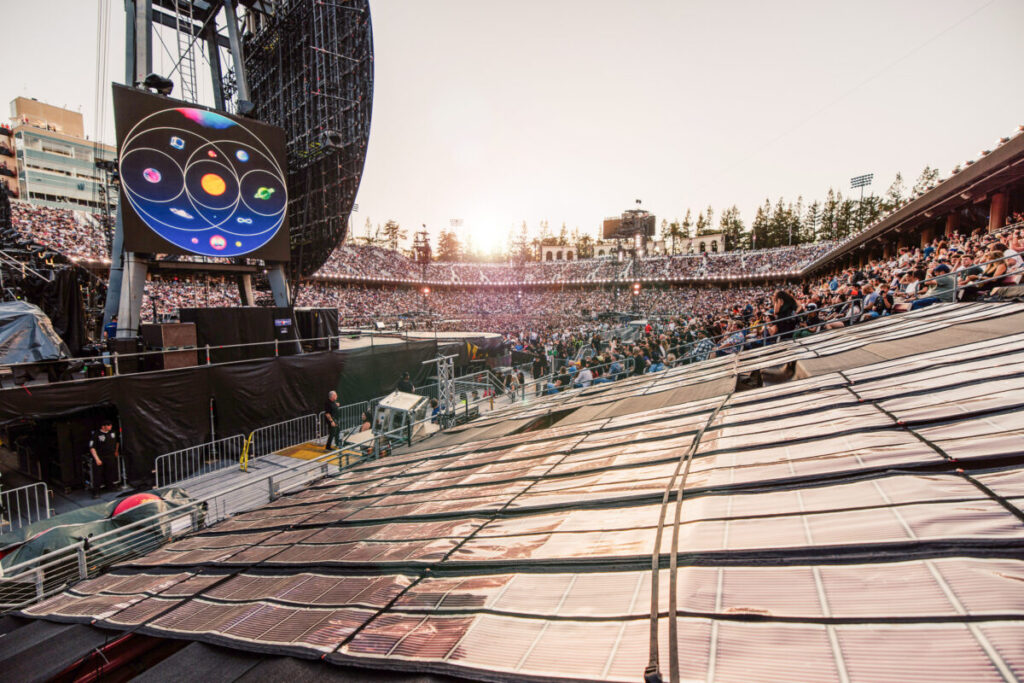The rollout today marks one of the largest live event implementations of mobile solar sun and offers a controversial test for organic, ink-based photovoltaic.
When Rock Band Coldplay Kardinia Energy from Australia challenged to design a mobile solar system that could travel the whole world with their world tour, Kardinia did not start with traditional panels. They started with a wine label printer.
Last weekend, the Retooled Machine Power Coldplays Stanford Stadium Shows helped with a roll-out of 550 square meters of ultra-light, recyclable printed solar energy in Cardinia’s North American debut. The sun was used to charge the set of rechargeable batteries from the tire that can feed 100% of the show.
The rollout today marks one of the largest live event implementations of mobile solar sun and offers a controversial test for organic, ink-based photovoltaic.
Cardinia CEO and co-founder Anthony Letmon told PV Magazine USA A few years ago, ColdPlay reached the startup in search of a solar solution that can be used and can be easily transported.
“They have set us a challenge,” he said.
The result is a paper-thine, plastic-based organic photovoltaic film with a weight of only 300 grams per square meter. Developed by Cardinia’s other co-founder, Paul Dastoor, a physics professor at the Center of Organic Electronics from the University of Newcastle, the Tech Silicon skips completely.
Image: Anna Lee Media
Instead, Kardinia presses carbon-based semi-conducting polymers on recyclable plastic sheets using a cheap printing process. The film can be rolled up as a tube of paper for transport and installed in less than two hours by a double crew with only ratchet and cable sheets.
Letmon said that the Stanford implementation marks one of the largest real-world demonstrations of mobile solar sun in a live music environment. And although the output of the sun has not yet been quantified in kilowatt hours, Letmon said that “what we know is that all the batteries we had to charge were charged.”
The Cardinia modules have been tested with Coldplay with Coldplay for more than 18 months, initially in smaller implementations. The latest upscaling was designed to test the energy output, sustainability and mobility of the technology and to show how printed solar energy can be integrated into a fast-moving global tour.
“It is a great site to see this small army coming in, to build a whole tour setup and to build a show within 24 to 48 hours,” said Letmon. “We had to find out how our systems would fit in and determine how we should adjust them to work best in every stadium.”
Although still a niche technology, Letmon noted that printed solar energy could open a new road for off-grid, quickly used solar energy in stadiums, warehouses and then.
Yes, the panels are not as efficient as silicon per square meter, he said, but they are uniquely suitable for surfaces where weight and shape are limiting factors such as lightweight roofs or disaster relief.
And, in contrast to conventional solar panels, there is little worries about management at the end of life, all that is done in -house by Kardinia.
“This is a completely recyclable technology,” Letmon added, and noted that the printed panels have been tested for four years on roofs in Australia and are still strong. Even with that potentially shorter lifespan, the low costs and recycling help the technical pencil.
“We don’t need a very long service life for the printed panels to pay for themselves,” he said.
This content is protected by copyright and may not be reused. If you want to work with us and reuse part of our content, please contact: editors@pv-magazine.com.
Popular content


